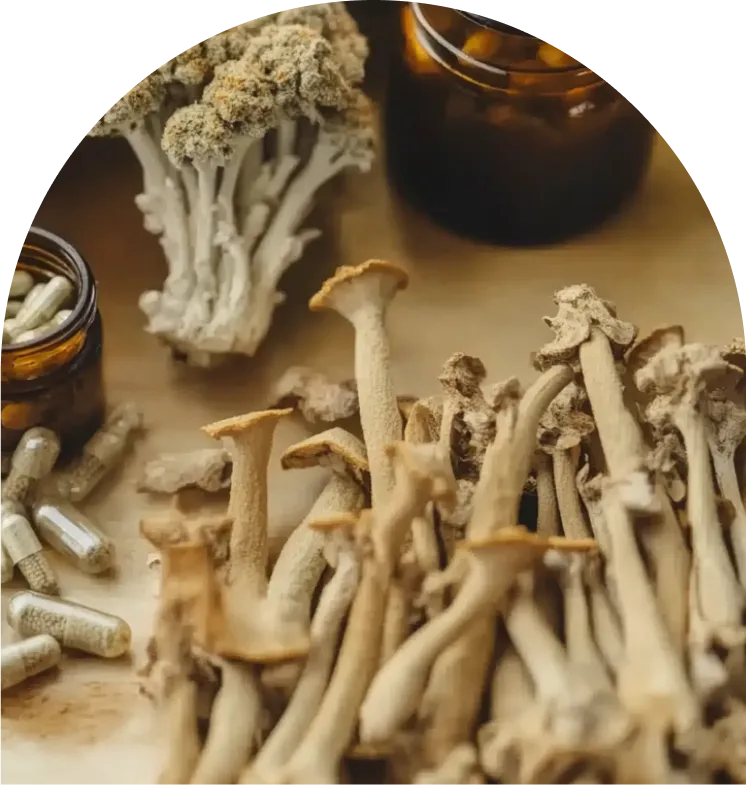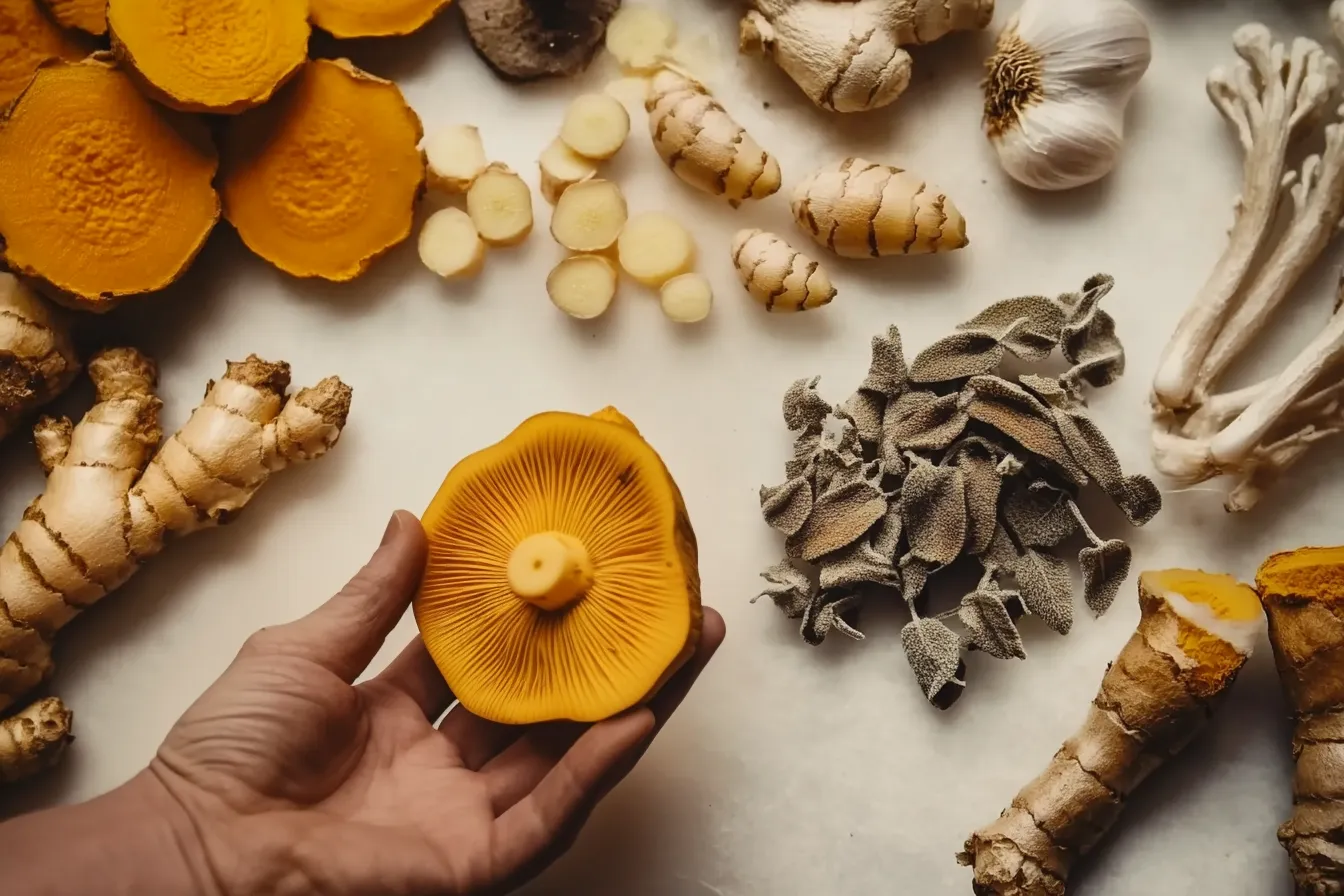
The modern psychedelic movement is focused on wellness and performance optimization.
Unlike past generations, inspired by cultural exploration or spiritual awakening, today’s movement is grounded in personal growth, stress management, and healing.
As a result, millions of people are microdosing, regularly consuming small amounts of psychoactive substances to help manage stress, increase happiness, and find balance —embracing what they see as a sustainable wellness practice akin to yoga or jogging.1
Although accessing classical psychedelics like psilocybin and LSD may be easier now than ever, it remains challenging. These substances are still illegal in most regions, adding a layer of risk to acquiring them. As a result, many new microdosers are turning to legal alternatives, exploring the potential of microdosing cannabis and other natural psychoactive plants and fungi.
Surprisingly, psychoactive substances are closer to home than you might think—right in your refrigerator, garden, or pantry. Everyday items like coffee, tea, alcohol, and tobacco all contain mind-altering compounds, and further, many common foods, herbs, and spices are known to subtly impact our health and mental state immediately after consuming them. 2, 3
Nearly every traditional culture has long-standing practices involving the plants and fungi native to their regions. These natural resources have been used for generations to promote health and well-being. This reliance on natural remedies in traditional medicine has laid the foundation for the modern return we are experiencing today, seeking balance and enhanced well-being through practices like microdosing.
- Willow Bark – Traditionally used by Native Americans for pain relief, contains salicin, a natural precursor to aspirin.
- Turmeric – Used in Ayurvedic and Southeast Asian cultures for its anti-inflammatory and healing properties.
- Ginger – Widely used in many cultures, including in Traditional Chinese Medicine, for its warming and digestive benefits.
- Cacao – Central to Mesoamerican cultures, where it was considered the “food of the gods” and used in rituals.
- Garlic – Revered in Mediterranean cultures for its medicinal properties, believed to prevent colds.
- Honey – Used across various cultures for its healing properties, including in Ancient Egyptian medicine.
- Mint – Valued in many cultures, including Ancient Greece, where it was used for digestive health.
- Elderberry – Used in European folk medicine for its perceived immune-boosting properties, particularly in treating colds and flu.
- Sage – Sacred in Native American cultures, often used to promote healing.
- Aloe Vera – Used in ancient Egyptian, Indian, and Chinese cultures for its soothing and healing properties, particularly for skin ailments.
Three lesser-known but increasingly recognized legal plant medicines—Kanna, Amanita Muscaria, and Peganum harmala —are gaining attention in modern psychedelic circles. As microdosing becomes more popular, these plants are being woven into wellness practices, offering fresh, legal alternatives for microdosing enthusiasts.
- Kanna, traditionally used by the Khoisan people of Southern Africa, is praised for its potential mood-enhancing and stress-relieving effects.
- Amanita Muscaria, the iconic red and white mushroom, holds ceremonial significance in various cultures and is being revisited for its potential calming and introspective qualities.
- Syrian Rue, used for centuries in Middle Eastern and Central Asian traditions, is recognized for its harmala alkaloids. These alkaloids have potent psychoactive and MAOI properties and have been used to support meditation practices.
BUT REMEMBER, with natural substances, caution is essential! All plant medicines can involve risk, even microdosing. These powerful substances should be approached with respect. Prioritizing your safety is essential as you explore these potent plant medicines. Always practice harm reduction strategies when trying any new substance, as individual reactions can vary. Make sure the substances you microdose are pure and not contraindicated with any medications or conditions you have. Consult a healthcare professional before trying any new substances, especially if you are pregnant, nursing, or may become pregnant.
What Is Kanna Extract?
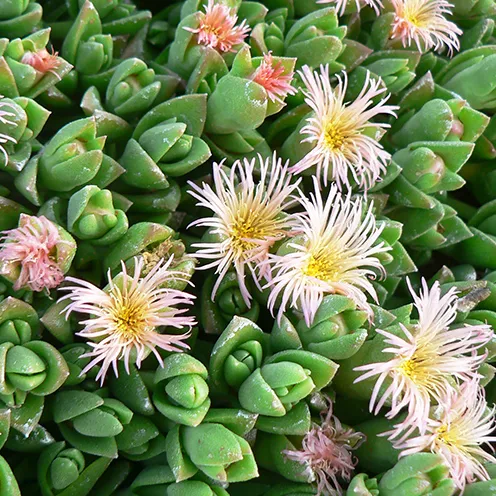
Kanna (Sceletium tortuosum) is a bright-flowering succulent native to arid regions of South Africa, abundantly so in Namaqualand and Kannaland. With its distinctive white, yellow, or pink flowers, this plant has been used for centuries by the indigenous San and Khoikhoi tribes (Khoisan people) in medicinal, social, and spiritual practices.4
Kanna extract is a potent concentrate derived from the Sceletium tortuosum plant, carefully processed to amplify its psychoactive effects. Rich in alkaloids (the active ingredient), it’s known by the Khoisan people for promoting relaxation, boosting mood, and reducing anxiety. Today, Kanna extract is gaining popularity in Western wellness practices as a natural supplement for stress relief and cognitive enhancement, which may offer a complementary approach to support one’s mental well-being.
Historical and Botanical Context
Kanna’s earliest documented use by Europeans dates back to 1662, when the Dutch traded for it with local tribes. 4
Kanna’s historical Indigenous name is “Kougoed,” a Khoisan word meaning “chewable stuff.
“. This is thought to be the earliest iteration of the name that would eventually become Kanna. The word Kougoed reflects the traditional method of consumption, where the plant was fermented, dried, and chewed. 4
Botanically, Kanna belongs to the Aizoaceae family, which includes around 1,900 succulent species.5 It thrives in hot, dry climates and is often found under shrubs in partial shade. The plant is adapted to survive harsh conditions with its thick, succulent leaves and ability to minimize water loss.
Chemical Composition and Effects
Kanna is known for its complex chemistry, containing 25 identified alkaloids, with mesembrine, mesembrenone, and tortuosamine being the most significantly researched.5 The alkaloids in Kanna, particularly mesembrine, act as serotonin reuptake inhibitors (SRIs), increasing the availability of serotonin in the brain, which is believed to contribute to Kanna’s mood-elevating effects.6
The best kanna extract is thought to come from kanna cultivated in its natural South African habitat, processed to increase bioavailability and potency. Traditional fermentation methods involving bruising and sun exposure are used before consumption to enhance the plant’s effects and reduce oxalic acid levels, which minimizes potential negative side effects. 7
Therapeutic Benefits
Kanna, often referred to popularly as “Nature’s MDMA,” has garnered attention for its potential to promote well-being and alleviate stress, as suggested by small preliminary studies.8 However, despite its long history of traditional medicinal use in South Africa, the plant has not yet been thoroughly researched to validate all the claims made about its therapeutic benefits in both traditional and modern contexts.
That said, here are some potential benefits of Kanna that are being explored:
Sleep Quality Improvement
Kanna is noted for its potential to improve sleep quality, mainly due to its sedative effects, which promote relaxation and restful sleep. 9
Anxiolytic (Anti-Anxiety) Effects
Kanna has traditionally been recognized for its potential anti-anxiety properties. It has been shown, in mice, to reduce stress and anxiety, and in humans, it has been studied experimentally in healthy participants to temporarily reduce anxiety from a stressful task.10,11 Although clinical research is lacking, it has been noted as a ripe area of research as a potential complementary approach for managing daily stress or nervousness. 12
Anti-Inflammatory: Kanna contains anti-inflammatory compounds; some laboratory studies show they may help reduce inflammation in cellular models of chronic diseases. 12, 13
Other possible benefits of Kanna, based on anthropological research into its traditional use, include mood enhancement, improved social Interaction, and pain relief. 14 However, these effects have not been scientifically evaluated.
Modern Usage and Legal Status
Modern cultivation, extraction, and manufacturing methods now allow for more precise dosing, leading to more consistent and predictable experiences.
Because of growing interest, this versatile medicine is now available in various forms, including Kanna gummies, edibles, vapes, raw powder, teas, tinctures, capsules, and smoking blends.
In the U.S.A, Kanna is legal to possess and consume, though the FDA doesn’t regulate it. Consumers are advised to purchase Kanna products from reputable, lab-tested sources.
(Like all plant medicine products, avoid buying them at the gas station!)
Usage Guidelines
There are no universal guidelines for the optimal dosage of Kanna, as clinical trials vary depending on the amount of the plant and the total mesembrine alkaloids. Kanna is typically energizing, so it’s best consumed in the morning. Regular use can lead to tolerance, making periodic breaks advisable. 15
It’s important to avoid mixing Kanna extract with other drugs or medications, especially antidepressants, blood pressure medications, erectile dysfunction drugs, anxiolytics, sedatives, or hypnotics. Additionally, pregnant or nursing women should avoid Kanna, and those with medical conditions should consult their healthcare provider before use.

How to Microdose Kanna
Because Kanna is a natural plant that can be extracted and prepared differently by various companies, there’s no consistent standardization as you’d find with synthetic substances like LSD. This variability makes providing a universal “beginner’s guide” to Kanna extract microdosing difficult.
Instead, we’ve chosen to feature KA! Empathogenics a trusted industry leader known for adhering to best practices. They offer premium Kanna extract products, backed by exceptional customer service and comprehensive product-specific education, ensuring a reliable and well-informed experience for users.
KA! Empathogenics is a top choice for anyone curious about exploring Kanna. Their products are user-friendly, beautifully packaged, and deliver on their promises. We recommend trying their Kanna Chews and Tincture, which are convenient and enjoyable introductions to exploring Kanna’s potential benefits.
At Microdosing.com, we define a microdose as sub-perceptual. Based on our experience, we recommend starting with 1/4 to 1/2 of a chew or up to 10 drops of tincture (about ½ a dropper). Adjust the dose as needed to maintain subtle, sub-perceptual benefits.
Kanna is a centuries-old plant used traditionally by the Khoisan Indigenous people of South Africa for its mood-elevating properties and other ceremonial uses. While some historical and preliminary studies show potential benefits, clinical studies are unfortunately lacking. It’s crucial to use Kanna responsibly, avoid mixing it with medications and other substances, read Kanna extract reviews, and choose products from trustworthy sources.
What Is Amanita Muscaria?
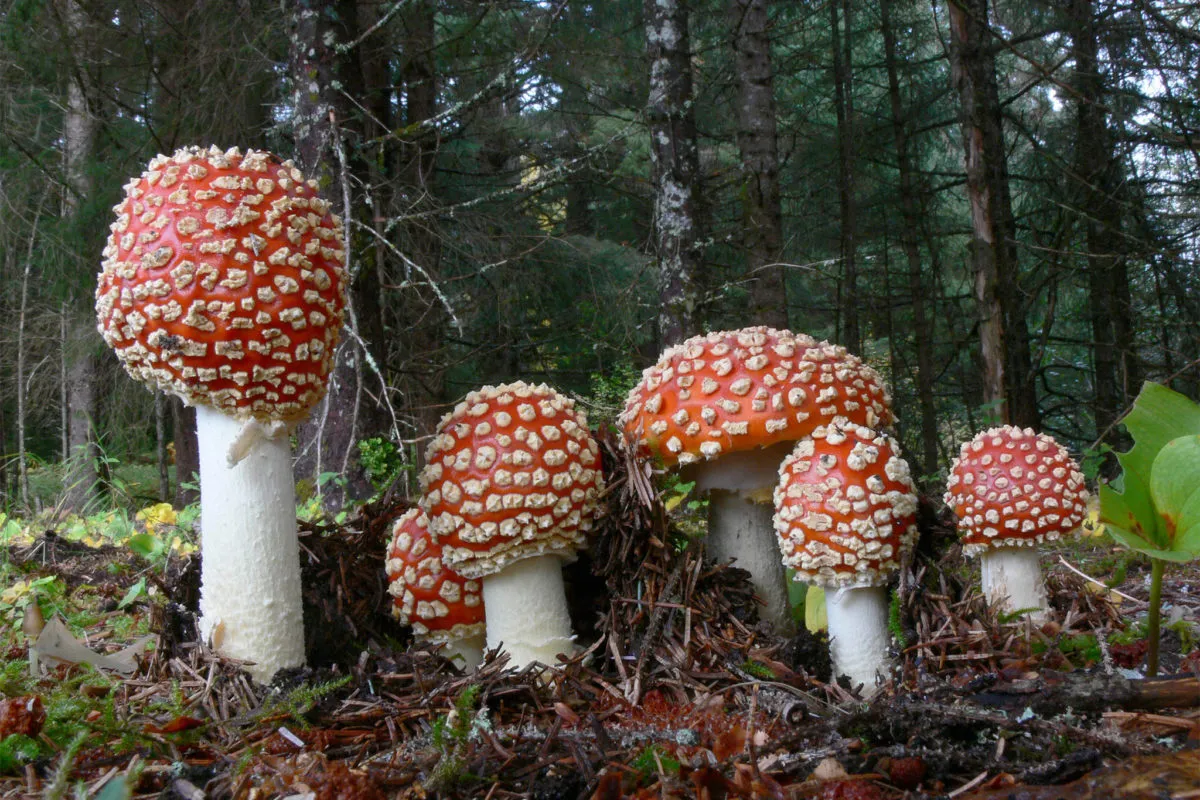
Amanita Muscaria, often called the fly agaric, fly amanita, or famously the Mario mushroom, is one of the most recognizable mushrooms on the planet. Its vivid red cap covered in white spots has become an emblem of the fungi kingdom, even represented as the mushroom emoji 🍄 on your phone.17
Native to temperate (cool) and boreal (northern) regions of the Northern Hemisphere, Amanita Muscaria has been intertwined with indigenous folklore, religious practices, and healing traditions for centuries.18 Revered for its psychoactive and hallucinogenic effects, it has played roles in spiritual ceremonies and medicinal practices throughout history. Today, it continues to captivate enthusiasts and researchers who delve deeper into its rich cultural significance and modern applications.
Historical and Botanical Context
The striking appearance of Amanita Muscaria has made it a central figure in the mythologies of numerous cultures, particularly among the indigenous peoples of Siberia and Northern Europe.19 In Siberian shamanic traditions, the mushroom is prepared and consumed to induce altered states of consciousness, which are believed to facilitate communication with the spirit world.20 Its ritual use is often accompanied by drumming and chanting, enhancing the visionary experiences.21
Botanically, Amanita Muscaria belongs to the Amanitaceae family, which includes some of the most well-known and studied fungi.22 This mushroom thrives in symbiosis with various tree species, mainly birch and pine, forming mycorrhizal associations that benefit both the plant and the fungus.23 While it is often found in woodlands and forested areas, its distribution is widespread, from North America’s coniferous forests to Europe’s deciduous woodlands.
Chemical Composition and Effects
Though raw Amanita is poisonous and should not be consumed, preparations of Amanita Muscaria are known for their potent psychoactive effects, primarily attributed to the compounds muscimol and ibotenic acid, believed to be responsible for the mushroom’s mind-altering properties.24 Muscimol, a decarboxylated (heated) by-product of ibotenic acid, binds to GABA receptors in the brain, activating the calming effects of this neurotransmitter.25 This may lead to a range of altered states, from relaxation and mild euphoria to intense hallucinations and dissociative experiences.
The presence of other alkaloids like muscarine adds to the complexity and potential risks associated with Amanita Muscaria consumption. Improper preparation, such as attempting to make your own extract (don’t), can lead to severe toxicity. Amanita Muscaria toxicity (poisoning) may include nausea, vomiting, agitation, and, in extreme cases, coma or death.
Therapeutic Benefits of Amanita Muscaria
Although clinical research on Amanita Muscaria is very limited currently, many are interested in accessing its therapeutic benefits. Long known for its striking appearance and psychoactive properties, Amanita Muscaria is gaining recognition in the modern world despite its association with toxicity.
Relying on different mechanisms for action than psilocybin-containing mushrooms, Amanita Muscaria’s effects are brought about by its active compounds—muscimol and ibotenic acid— which engage the GABA receptors and are known to promote relaxation and induce drowsiness.26
Legal Status
In the U.S., Amanita Muscaria is legal to possess and consume in all states except Louisiana, though it is not regulated by the FDA.
Usage Guidelines for Amanita Muscaria
This unique mushroom is available in various forms, including amanita mushroom gummies, vapes, and tinctures. Due to recent FDA recalls involving similar products, we recommend additional caution when seeking amanita products. 27
Avoid combining Amanita Muscaria with other substances, particularly alcohol, antidepressants, or medications for high blood pressure or erectile dysfunction, as these combinations can be dangerous. Pregnant or nursing women should not use Amanita Muscaria, and individuals with existing medical conditions should consult a healthcare provider before use.
How to Microdose Amanita Muscaria
Microdosing Amanita Muscaria may offer a way to explore potential benefits from Amanita, but it’s essential to recognize that research on its efficacy, especially in microdoses, is still limited. Additionally, the raw form of Amanita Muscaria is toxic, so it’s crucial only to use professionally processed extracts. We strongly discourage attempting to make your own extracts, as improper preparation can lead to dangerous outcomes.
Fortunately, modern preparations like those from Psyched Wellness provide standardized, precisely dosed extracts, ensuring a safer and more consistent experience. Their Calm tincture (AME-1) is our top recommendation for those interested in microdosing Amanita Muscaria, as it offers a high-quality, well-processed product tailored for this purpose. With their attention to detail and safety, Psyched Wellness makes microdosing this potent mushroom much more predictable and accessible.
- Be Sure About What You Are Taking
- Determine Your Dosage
- Microdosing Protocol
Check the Ingredients List: Avoid products that list a “proprietary blend,” as this typically means the exact contents and concentrations are not disclosed. This is especially important to look out for in amanita muscaria gummies and edibles, which may be easily mislabeled.
Avoid Raw Products: Never consume raw Amanita Muscaria or in any product that does not clearly state its preparation method and potency.
Liquid Extracts Only: For safety, use only a quality liquid extract of Amanita. Liquid extracts are typically standardized and allow for more precise Amanita muscaria dosage control.
Starting Dosage: Following the general recommendation that a microdose is 5-20% of a full dose. To gauge your body’s response, you could begin with a low dose, such as 0.4 ml (20% of the manufacturer’s recommendation) of the liquid extract.
Gradual Adjustment: If the initial dose is well-tolerated, you can gradually adjust the amount in small increments. The goal is to find a dose that provides the desired effects without leading to overstimulation or sedation. Note that long-term use hasn’t been well studied, so it’s best to discuss an informed healthcare provider.
From our team’s personal experiences and explorations. Note that microdosing protocols have not been well established in the scientific literature for Amanita. Your own personal experience may differ.
Timing: Because many experience gentle sedative effects when Microdosing Amanita Muscaria, it may be best consumed in the evening. The mushroom’s calming effects, which promote relaxation and mild drowsiness, could be suited to winding down at the end of the day and preparing for restful sleep.
Frequency: One approach we explored is to microdose once a day in the evening for a period of one month, followed by a break. This may allow you to monitor the effects on your sleep patterns and overall relaxation.
Evaluate and Adjust: Take a break to evaluate the effects on your sleep and relaxation. Based on your experience, you can adjust the dosage or frequency to better suit your needs.
Microdosing Amanita muscaria has not been examined extensively in formal scientific environments.28 However, anecdotal reports indicate that some of those who’ve tried it report some benefits, specifically help with relaxation and sleep. The raw mushroom is poisonous, so if you are interested in trying it, it’s essential to find an extract made by a trusted source.
What Is Espand (Syrian Rue)?
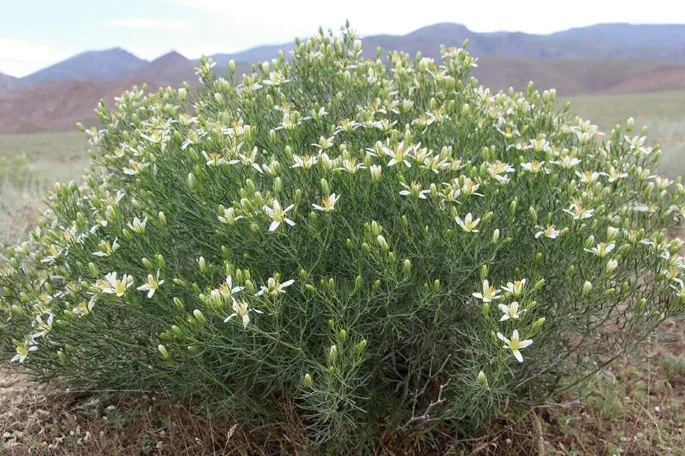
Espand, also known as Syrian Rue or Peganum harmala, is a resilient perennial herb that flourishes in the arid, saline soils of temperate desert and Mediterranean regions.29 Its native range spans countries such as Afghanistan, Iran, Tajikistan, and parts of India and Pakistan, where it has long held cultural significance.
Revered for its protective properties, Espand is traditionally burned in ceremonies to ward off the “evil eye” and negative energies.30 Beyond its use in folk practices, this potent plant has gained attention for its psychoactive alkaloids, which are being studied for their potential therapeutic and medicinal applications, making it a focal point of modern research.
Historical and Botanical Context
Espand, has been celebrated for centuries. Traditionally, its seeds, flowers, and fruits have been key components in folk medicine across the Middle East and Central Asia. Known for its powerful protective qualities, Syrian Rue is burned in homes and sacred spaces, a testament to its deep-rooted spiritual importance.31
From a botanical perspective, Peganum harmala belongs to the Zygophyllaceae family and has attracted significant interest in modern ethnopharmacology, with researchers investigating its potential for treating conditions such as anxiety, pain, and neurodegenerative disorders.32, 33, 34 This fusion of ancient healing traditions and modern scientific inquiry positions Syrian Rue as a unique link between traditional wisdom and possible medical advancements.
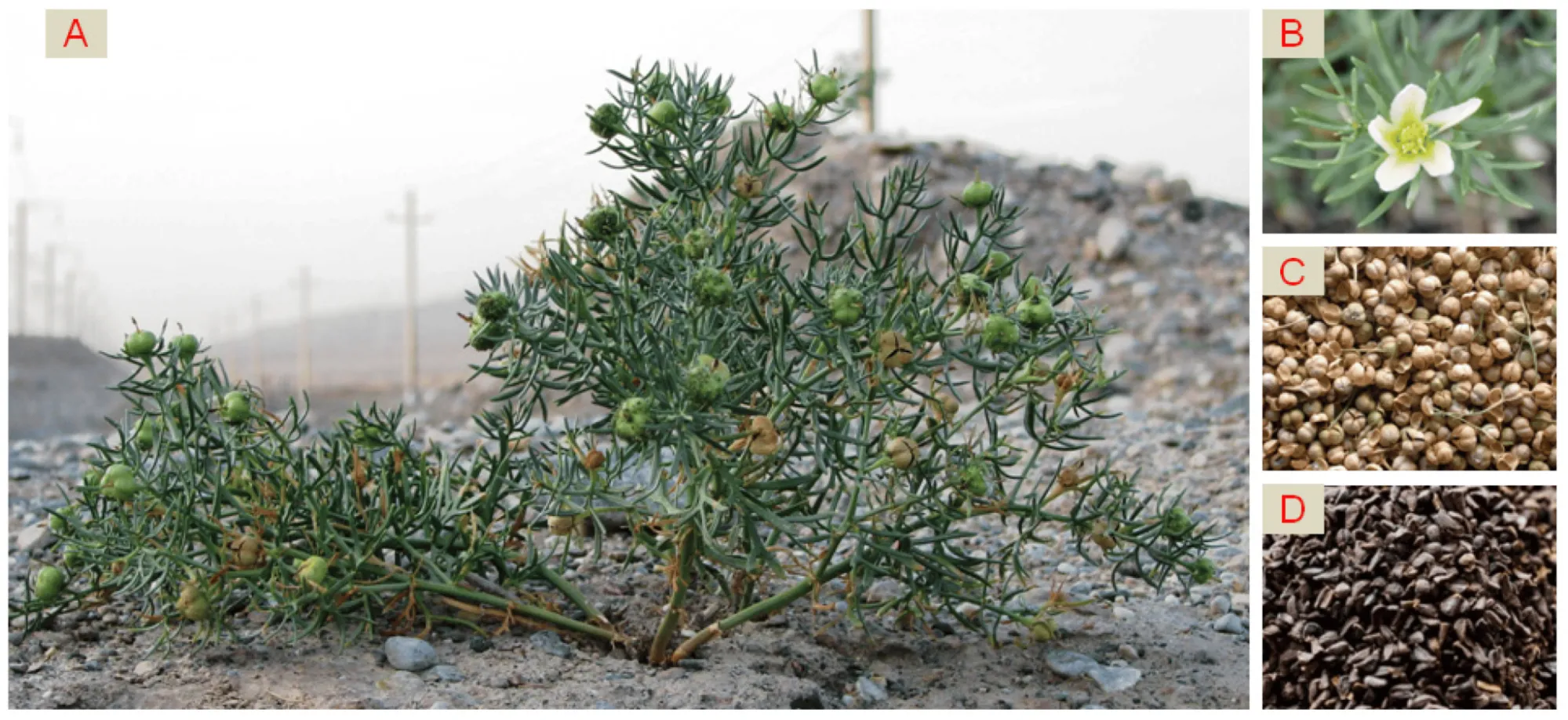
Figure 1. P. harmala (A) plant; (B) flower; (C) ripe fruits; (D) seeds.
Chemical Composition and Effects
The harmala alkaloids, which are responsible for Espand’s psychoactive and medicinal properties, include harmine, harmaline, and tetrahydroharmine, each of which have various effects on the body. Notably, these alkaloids are potent monoamine oxidase inhibitors (MAOIs) that significantly impact the brain’s neurotransmitter systems, particularly by influencing serotonin and dopamine levels.35 This MAOI activity can interact dangerously with certain foods and medications, making careful usage imperative to avoid harmful consequences.
At low doses, Espand can produce stimulant and mild hallucinogenic effects, larger doses can be toxic, leading to severe side effects such as nausea and vomiting.36
Therapeutic Benefits of Espand
Anecdotal reports suggest that microdosing a tea or extract made from the seeds of espand may influence mood, helping to reduce stress and anxiety.38 Its reputation for promoting deep meditative states has also made it a favored tool in spiritual practices. However, despite these promising anecdotal experiences, clinical research on Espand remains limited, and the safety of long-term use has not yet been established.
In traditional Iranian medicine, Syrian Rue’s seeds have been used to treat digestive issues, respiratory conditions, and even parasitic infections.39 The plant’s psychoactive effects, particularly its ability to inhibit monoamine oxidase, have also led to its exploration as a potential treatment for mental health conditions, such as depression and anxiety.40
Syrian Rue has a long history of being used as an abortifacient in traditional medicine, underscoring the serious risks it poses for pregnant women.41 Its potent alkaloids can stimulate uterine contractions, which may lead to miscarriage or complications in pregnancy. As a result, it is critically important that pregnant or breastfeeding women avoid any form of Syrian Rue, whether in teas, extracts, or microdoses. Even small amounts could pose significant risks, making its use during pregnancy highly dangerous. Anyone considering Syrian Rue should consult a healthcare professional to fully understand the potential risks, especially if there is a chance of pregnancy.
Modern Usage and Legal Status
Today, Syrian Rue is available in several forms, including seeds, extracts, and capsules. It is legal to possess and use in the United States, though it is not regulated by the FDA. As with any potent plant medicine, it is crucial to purchase Syrian Rue products from reputable sources to ensure safety and quality.
How to Microdose Espand (Syrian Rue, Peganum Harmala)
Given the potential risks associated with Syrian Rue, particularly due to its potent MAOI activity and influence on pregnancy, it is crucial to approach its use with caution. The safest option for consumers is to purchase Syrian rue extract pre-dosed supplements from reputable vendors.
Ancestral Magi is a vendor that provides a diverse range of Espand-derived products, each carefully formulated to serve specific wellness needs. These offerings include formulations of Espand along with other plant supplements –designed to promote calm, improve sleep quality, and boost energy levels. By tailoring their products to various purposes, Ancestral Magi allows individuals to explore the unique effects of Espand in ways that align with their personal wellness goals.
Microdosing Protocol:
There unfortunately aren’t widely researched microdosing protocols at this time.
Since Ancestral Magi offers a variety of Espand products, it’s important to follow the specific instructions provided on the packaging to ensure you receive the intended benefits while minimizing risks associated with improper dosing.
Microdosing Espand requires careful attention to dosage to avoid side effects. Ancestral Magi offers products tailored to different needs, with their microdosing recommendation being once a day, adjusting the time of day based on the desired effects.
Although the company doesn’t explicitly suggest taking breaks to prevent tolerance, it may be beneficial to follow a Fadiman-style protocol: microdose for 4-6 weeks, followed by a 2-4 week break to assess any changes in mood, energy, or perception. However, this is still a theoretical approach and has not been formally validated.
Microdosing Syrian Rue may offer mood-enhancing benefits, but research is limited, and caution is essential due to its potent MAOI effects and potential interactions. Always use a reputable extract for safety.
Conclusion
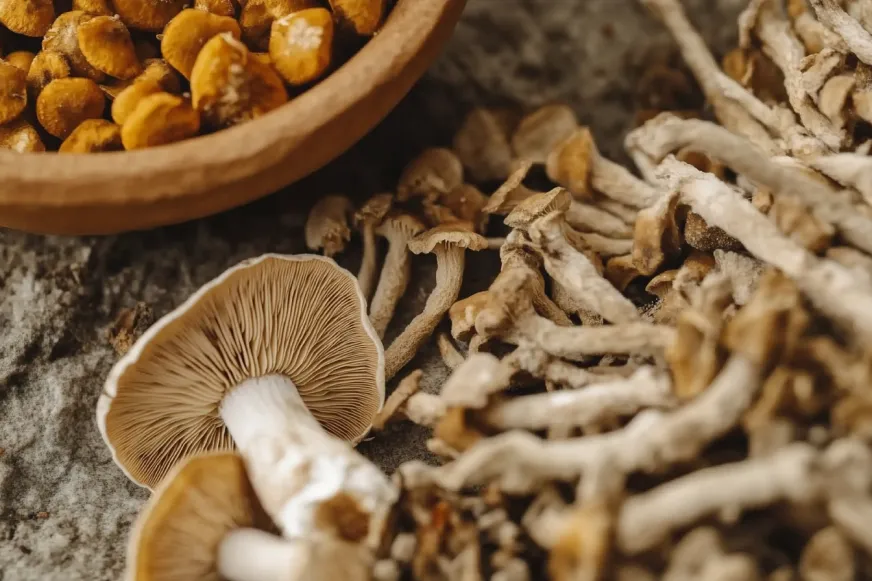
As interest in natural and legal microdosing grows, Kanna, Amanita Muscaria, and Espand (Syrian Rue) emerge as intriguing plant medicine options for those seeking to enhance their well-being. Each of these substances has a rich history rooted in traditional use, with varying research showing potential benefits ranging from mood enhancement and cognitive support to relaxation and spiritual exploration. However, these are not your average herbal supplements given their potential psychoactive qualities. Clinical research is still limited, and their potency demands careful, respectful use.
Whether you’re aiming to boost your mood with Kanna, tap into the calming effects of Amanita Muscaria, or deepen your meditation practice with Espand, safety should always be a top priority. Opt for products from reputable, lab-tested sources and follow recommended dosages to avoid any unwanted side effects. Even though these substances are legal, they can still interact with medications or existing health conditions, so it’s important to consult with a healthcare professional before starting a new microdosing regimen.
As you embark on your microdosing journey, remember that every experience is unique. Pay close attention to how your body responds, adjust your dosage accordingly, and take regular breaks to ensure these powerful plants continue to support your wellness goals. The purpose of microdosing is to elevate your life, not overwhelm or disrupt it—so approach mindfully and savor the subtle yet profound experiences these natural allies may offer.
